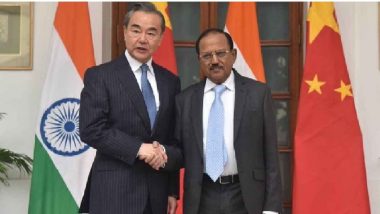Amsterdam [Netherlands], June 20 (ANI): The recent clash between Chinese and Indian Army personnel at the Galwan area along the Line of Actual Control (LAC) on June 15, that led to the tragic loss of lives on both sides, have impacted the future trajectory of the broader India-China relationship and diluted the arduously worked out rules of engagement along the border, a European think tank has said.
"The Chinese attack has led to China's most serious security situation with India in recent years, and flared emotions have meant that the potential for rapid escalation is rife," the Amsterdam-based European Foundation for South Asian Studies said in a report published on Friday.
Quoting experts, the think tank said that the Chinese attack marks the "21st century turning point for India and China", and that the two countries face a future characterized by deepened distrust and potential fresh conflict.
"The attack on Indian troops comes on the back of an increasing Chinese assertiveness, be it in the South China Sea, Taiwan or Hong Kong. China has been flexing its muscle across the region, intercepting Malaysian and Vietnamese vessels in the South China Sea, seizing new powers over Hong Kong and twice sailing an aircraft carrier through the sensitive Taiwan Strait," the report said.
Also Read | Singapore: Indian National Jailed for GST Fraud and Money Laundering.
The face-off between the two sides blows away the ambiguity over the fact that China has been testing the limits of international laws, conventions and norms, and the attack on the LAC was the latest and most serious manifestation, it added.
India responded to this Chinese aggression by sending in reinforcements to the area, and since then hundreds of soldiers from the two countries have been facing off just a few hundred meters from each other in the valley of the Galwan river.
India is carrying out various infrastructure projects near the LAC, especially the road construction to link forward points along the LAC to the nearest airport at Daulat Beg Oldi in Ladakh. Such constructions would enable quicker military mobilization and strategic advance by India but on the other hand appeared to have unsettled China, the EFSAS said in the report.
Furthermore, India has opposed the China-Pakistan Economic Corridor (CPEC), the multi-billion dollar flagship of China's much touted Belt and Road Initiative (BRI), which passes through in close proximity to the area where the construction is taking place.
Based on the decisions taken at a 6 June meeting between senior Indian and Chinese military officials, India on 15 June sent a party of soldiers to check whether Chinese forces had withdrawn from a particular point in the Galwan valley that they were supposed to have vacated. These Indian troops were attacked by a large contingent of Chinese soldiers armed with iron rods studded with large nails and large stones wrapped in barbed wire.
The protocols in place at the LAC since the early 1990s prevented troops from both sides from firing weapons in order to avoid escalation. Both sides called for reinforcements after the Indian troops retaliated to the attacks. The ensuing melee went on for hours in the darkness, and was bloody and messy. The harsh climatic conditions at the altitude of 5000 meters also contributed to the number of casualties.
"Despite China's belligerence, its reluctance to make public the number of troops that it lost on 15 June displayed its soft underbelly at the LAC. It also reflected a contradictory wish to prevent the clashes from escalating. The response of the Chinese government to the LAC clash was also conspicuously low-key, unlike incidents in its other military theaters such as the Taiwan Strait, where minor provocations by the US military often lead to bellicose warnings from Beijing," the think tank noted.
In addition to the above, the absence of a formal boundary and the differing perceptions regarding the alignment of the LAC have repeatedly resulted in disagreements and violent clashes, and this situation is not going to change till a formal border is agreed upon.
India has however made it clear that though it has little appetite for violent clashes, it will not stand down to Chinese intimidation. The same was also precisely pointed unambiguously by Prime Minister Narendra Modi in a televised address on 17 June.
"India would much prefer a diplomatic solution to the border issue with China. Meanwhile, the present international milieu in which China finds itself under severe pressure from several quarters could be well utilized by India to its advantage," the report stated. (ANI)
(This is an unedited and auto-generated story from Syndicated News feed, LatestLY Staff may not have modified or edited the content body)













 Quickly
Quickly





















